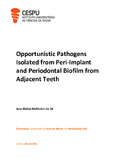Opportunistic Pathogens Isolated from Peri-Implant and Periodontal Biofilm from Adjacent Teeth
Resumen
Even though most studies consider strict anaerobe Gram-negative bacteria as the main
factor associated with peri-implantitis, other studies have identified other
microorganisms present in implants and related to peri-implant disease that have the
ability to reduce the effectiveness of treatment, such as Candida spp., Enterococcus
faecalis and Pseudomonas aeruginosa. Therefore, microbiologic diagnosis is important
for the success of implant treatment. The main goal of this study was to detect Candida
spp., E. faecalis and P. aeruginosa in periodontal and peri-implant biofilms in the
presence or absence of disease and relate the presence of these microorganisms with
demographic data, systemic diseases, hygiene habits, the type of implant connection and
endodontic treatment. The study population consisted of 20 patients that filled out a
questionnaire regarding gender, age, systemic diseases, and oral hygiene. Peri-implant
and periodontal biofilms from an adjacent tooth, both with and without disease, were
analysed for the presence of these three opportunistic pathogens. Microbiological
analysis revealed a higher prevalence of E. faecalis in patients with and without
periodontal and peri-implant disease. Candida spp. was identified in a higher degree in
cases with disease, and P. aeruginosa was mostly detected in peri-implantitis. The
detection of these three pathogens suggested a possible means of transmission of
infection from adjacent teeth to implants, with implant design associated with
rehabilitation as a primary cause of pathogen growth. Although this study did not relate
pathogen growth directly to periodontal disease, the high values UFC/mL values of E.
faecalis may reveal an etiologic role of this bacterium in peri-implantitis.

